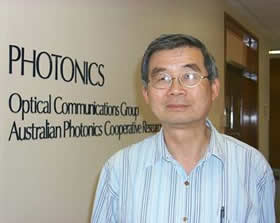About
In Memoriam: Pak Lim Chu,
Mar 15, 2008
In Memorium: Professor Pak Lim Chu
12 November 1940 – 15 March 2008
|
The world of photonics has lost a great champion and a pioneer of fibre optics in Australia with the passing of Professor Pak Lim Chu, who died on March 15, 2008, after a year’s battle with cancer. An OSA Fellow since 1992, Pak was a leading international photonics research scientist, a pillar of the Chinese Christian Church, a regular contributor to local Chinese newspapers and a former Chairman of the Society for Chinese-Australian Academics.
Pak’s was born in Guangdong Province during the Japanese occupation of China during World War II. When Pak was a young child, his father moved to the US in order to find work. In 1949, the year the Chinese Communist Government came to power, his mother moved with Pak to Hong Kong. Thereafter attempts by his mother to reunite the family in the US were thwarted by successive US and Canadian Government immigration services. So, in order to continue his education, Pak came instead to Australia in 1959 by himself and began his long career at the University of New South Wales (UNSW).
In 1965 a major milestone occurred that would dramatically affect Pak’s future career when Antoni (Toni) Karbowiak, became Chair in Communications in the Department of Electrical Engineering and formed the first optical fibre research group in Australia. Under Toni’s supervision Pak researched radiation from corners in surface wave transmission lines for his final year undergraduate project and graduated in 1965. There followed the Master of Engineering degree in 1966 and a Ph.D. in 1971. Pak then moved to a lectureship at the University of Technology, Sydney, before returning to Toni’s group two years later. His return to UNSW marked the beginning of his involvement with guided wave photonics for more than 30 years culminating in his Headship of the Optical Communications Group (OCG).
Over the years Pak managed a very productive research group at UNSW, active in both theory and experiment. One of the earliest laboratory developments was a preform lathe and drawing facility for glass fibre fabrication; there followed a simple classical ray tracing method for determining the refractive index profile of a fibre from the fabrication preform. This idea subsequently evolved elsewhere into what is now a standard piece of fibre characterisation equipment found in all fabrication laboratories. Later interests included the non-linear phenomenon of solitons, polymer fibres, fibres doped with rare-earth elements, multi-core fibres, planar waveguides and devices, sensing and particularly the fibre hydrophone, and other diverse fibre applications.
Pak was a traditional academic, fascinated by pure research but with no great interest in the commercial development of these ideas. He supervised numerous doctoral and honours students and also developed the first undergraduate course in Australia in the new optical communications technology.
Pak raised substantial research funds from contracts and consultancies with various government and industry organizations. One UNSW-based collaborative GIRD grant with Siemens Ltd, ANU and the University of Sydney led to the successful development of a practical twin-core fibre coarse wavelength de-multiplexer. Another success was the plasma-based technology used in planar waveguide fabrication that was developed in his group and led to the formation of the CRC spin-off company Redfern Integrated Optics (RIO).
In 1976 Pak organised the first Workshop on Optical Fibres, held at UNSW, which brought together researchers in fibre optics from academic, government and industrial organizations. The workshops rapidly grew in popularity until their size exhausted the ability of volunteers to organise and manage them. In 1983, Pak invited the (now defunct) Institution of Radio and Electronics Engineers (IREE) to take over management of the event. As a result, the first in the long-running series of Australian Conferences on Optical Fibre Technology (ACOFT) was launched in 1984. In later years Pak also became heavily involved in the international series of conferences on polymer optical fibres and in several Asian photonics conferences.
Pak was a popular speaker and the author of almost 500 conference and journal papers. He was a Fellow of several scientific societies including the Australian Technological Society and the Optical Society of America. In 2001 he was awarded the Centenary Medal of Australia for his contribution to optical communications.
In 2001 Pak retired from UNSW and moved to the City University of Hong Kong in Kowloon where he became Professor and Director of the Optoelectronics Research Centre. Pak remained in this position until reaching the University’s normal retirement age of 65. Then in 2006 he joined a local company, Cotco Holdings, to continue his photonics interests for the rest of his time in Hong Kong.
Pak is survived by his wife Eva, daughter Evelyn, son Desmond and five grandchildren.
This obituary was contributed by Professor John Love, Australian National University

